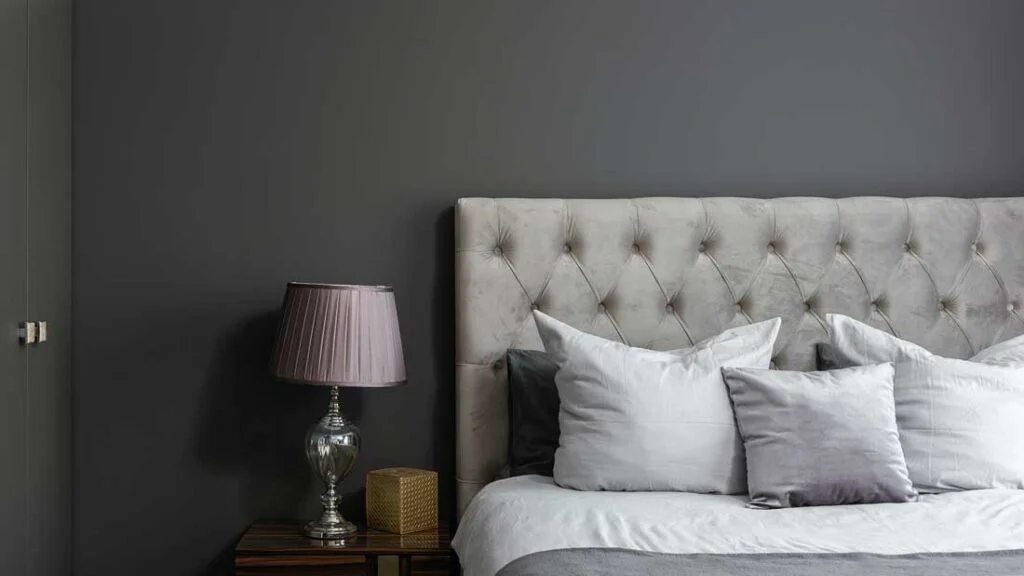
Between televisions, laptops, and even fitness equipment, many bedrooms often serve as multi-purpose spaces — and that’s probably not great for the quality of your sleep. “I don’t think we realize how important our environment is for sleep onset,” Dr. June Seliber-Klein, MD, DABPN, sleep medicine specialist, tells Sleepopolis. That’s why creating a good sleep environment with ideal conditions is a big part of proper sleep hygiene, improving the likelihood of more restful nights. From your bedding to how you manage sound and light and even the colors on the walls, making appropriate decisions about the design and elements in your sleep environment can have a profound impact. Here’s what to keep in mind.
Long Story Short
- Your bedroom should be designed as a sleep sanctuary to promote rest and relaxation. Factors like comfortable bedding, an organized space, and soothing colors can help.
- Be mindful about using screens in the bedroom to support a healthy circadian rhythm.
- Consider tools like weighted blankets and sound machines to promote relaxation and manage disruptions.
Pick the Right Bedding
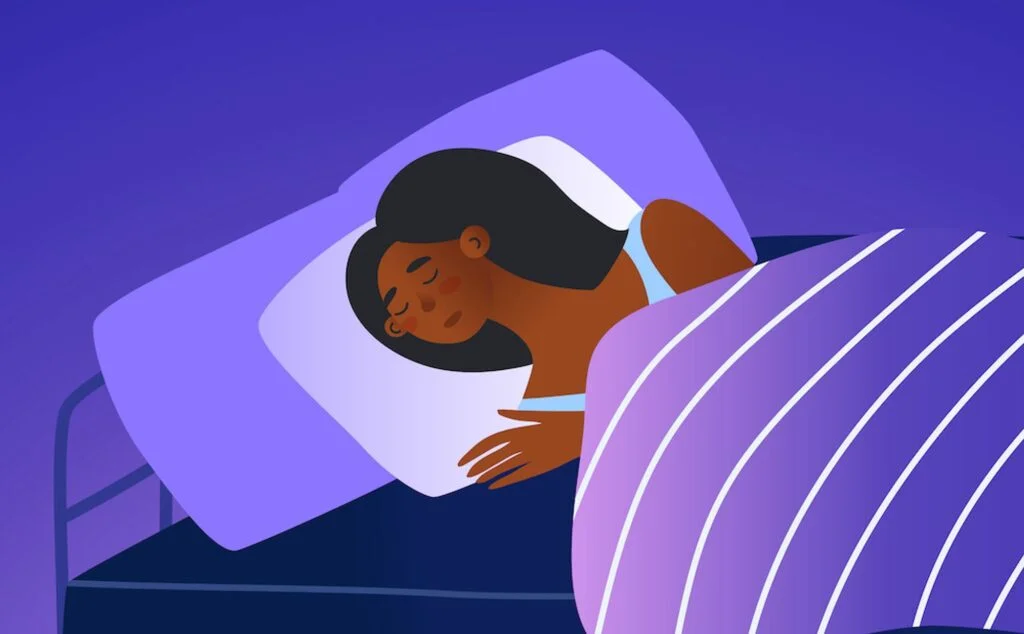
Anyone who has tried to sleep on a lumpy, sagging mattress knows firsthand the importance of a mattress that delivers on both comfort and support. The same is true of a pillow that cradles your head and neck in whatever position you prefer. “However you like to set up your bedroom, remember to have a pillow and mattress you find comfortable for your sleep style,” Christine Stevens, a sleep consultant and coach for exhausted professionals, tells Sleepopolis. She says the idea isn’t just a bed that looks inviting, but one that you find personally cozy and relaxing.
That means choosing linens and comforters wisely, too. “Bedding, pillows, sheets, and blankets are an important component of comfort,” Lauri Leadley, clinical sleep educator at Valley Sleep Center, tells Sleepopolis. Beyond appealing to our desire for softness and comfort, they also play a role in temperature regulation. Depending on where you live or the time of the year, you may need to switch your bedding to something lighter or heavier to ensure you stay comfortable. Hot sleepers, for example, should consider cooling bed sheets that breathe well to avoid waking up soaked in sweat.
Declutter
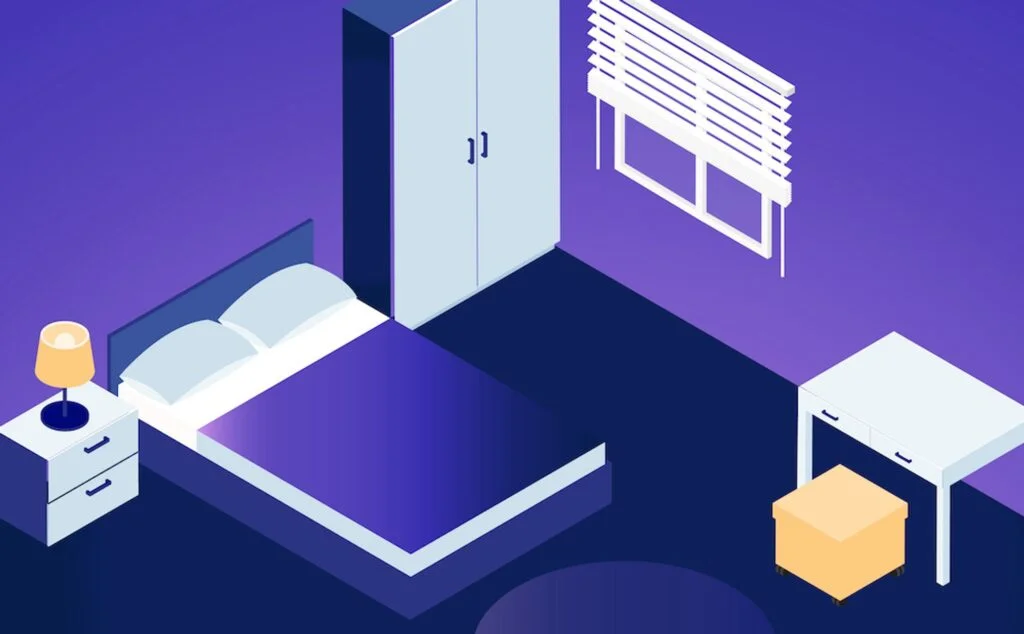
Both Stevens and Seliber-Klein say that clutter is a hurdle to a good night’s sleep for a few reasons. “When you’re creating a sleep sanctuary, having a bedroom stacked to the gills with stuff, laundry baskets everywhere, and piles of random items on top of every surface can leave you feeling overwhelmed and anxious,” says Stevens.
While research into the effects of clutter, specifically in the bedroom, is limited, studies have drawn a negative association between clutter and perceived well-being (1)(2). What’s more, researchers have linked stress and anxiety to sleep loss (3), so if you find a messy or disorganized bedroom unsettling, consider taking steps to remedy it. Stevens recommends a minimalist bedroom design with clean, cleared surfaces and storage solutions for all your belongings.
Get Organized
Organizing your bedroom space serves a few purposes. There’s a functional aspect that means clear space for movement to and from your bed and other bedroom furniture, but there’s also a psychological component. Organizing your bedside table, for example, makes it easy to reach for your glass of water, book or the hand lotion you apply before bed. Keeping your dresser organized makes it easier to find what you need first thing in the morning. Some research has associated clutter with increased stress levels and a decreased sense of overall well-being, so the idea of an organized bedroom is creating a greater sense of ease and efficiency, which can contribute to a greater sense of calm and relaxation (1).
Consider Blackout Curtains
Managing light is a key component of good sleep. “Our bodies are naturally programmed to function on a cycle that matches the solar day,” Dr. Jie Zhao, a research scientist studying indoor environments, tells Sleepopolis. “This cycle, known as the circadian rhythm, governs many aspects of our physiology, metabolism, and behavior.” Night shift work and other conditions can also alter your cycle.
Notably, the circadian rhythm is primarily synchronized by light, which means light exposure at bedtime can have a stimulating effect (4). Depending on the time of year or your schedule, you may go to bed or wake up at times that don’t align with the sun. Blackout curtains and sleep masks can help create the darkness you need to fall or stay asleep, no matter what’s happening outside.
Rethink Your Color Scheme
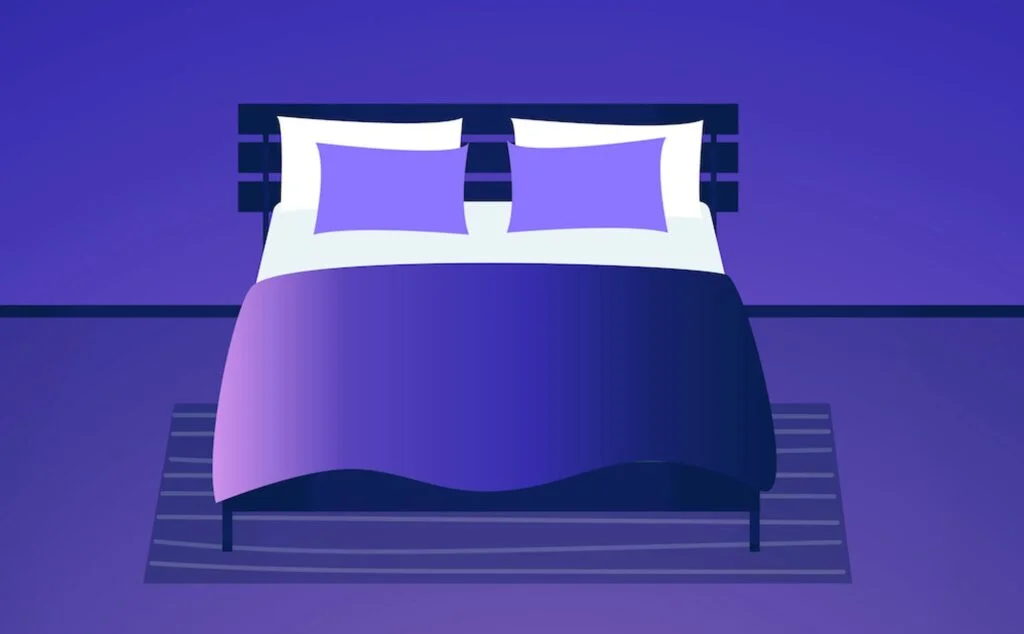
The colors in your bedroom should make you feel relaxed. Generally, a soothing color palette is softer and warmer, but this is subjective. “Research shows colors can affect our mood, mental performance, and behavior,” Dr. Chester Wu, who is double board-certified in psychiatry and sleep medicine, tells Sleepopolis. “But there’s not a lot of research into color psychology when it comes to the best bedroom colors for sleep and the research we have is problematic and inconclusive.” His advice is to choose colors that you like.
You can also look to the research of color psychologists, who often say the link between colors and emotions are fairly universal. That means most people tend to associate red with love and anger, yellow with joy, black with sadness and soft shades of blue and green with serenity — something to keep in mind when you choose colors for your bedroom (5).
Consider Aromatherapy
Aromatherapy, particularly with scents like lavender, is often recommended for promoting sleep. A review of 20 studies on the effect of lavender on sleep quality showed that inhaled lavender helped improve sleep quality among participants (6).
Beyond some studies on lavender, findings on aromatherapy are limited; however, while there isn’t a ton of research to show if it is effective for sleep, there are studies that find mood improvement as one of aromatherapy’s benefits (7). “My advice is to use it if you like it and think it helps you sleep,” says Wu.
Keep Screens Out of the Bedroom

When it comes to screens in the bedroom, there are two issues. First, “the blue light emitted from screens can suppress melatonin production, making it difficult to fall asleep,” says Wu. If you’re going to watch TV or scroll through your phone around bedtime, Wu recommends putting on blue-light-blocking glasses 90 minutes before bedtime or setting devices to night mode.
The second issue — and what Wu calls the bigger worry — is what’s on those screens. He says the content itself can be arousing or addictive, which could eat into sleep time or make it difficult to fall asleep. “Additionally, the constant notifications and the temptation to check your devices can prolong sleep onset and wake you up once you’ve fallen asleep,” he says.
On the other hand, some devices and apps are designed to be used in the bedroom to help promote sleep. The key is using them responsibly and minimizing the potential for disruptions once you’re asleep.
Consider Softer Lighting
Softening the lights in your bedroom can contribute to a cozy, relaxing ambiance. Installing dimmers or adding lamps makes it easy to soften the brightness of overhead lighting as you prepare for bed, which can help support a healthy circadian rhythm (8).
Create a Separation Between Work and Sleep
Bringing your work to bed isn’t what most people would consider relaxing. But there’s a bigger issue at play. “Reserving the bedroom for only sleep and sex is an evidence-based practice that reinforces a psychological association between the bedroom and restful activities,” says Wu.
If you’re tight on space and your bedroom must also function as a home office, do your best to create a separation between sleep and work. A streamlined desk (remember to keep it organized and clutter-free!) and chair can serve as a functional workspace without overwhelming the serenity of your bedroom. In bigger spaces, you may also consider a physical screen to block your workspace entirely from view.
Consider a Weighted Blanket
For people who experience anxiety or regular stress, a weighted blanket can be surprisingly effective. These blankets are filled with glass beads or pellets to create a weighted effect similar to a body-wide hug. While scientists are still trying to figure out exactly how they work, one theory is that the gentle pressure promotes the activation of the parasympathetic nervous system. This decreases both the heart rate and blood pressure, which reduces anxiety and helps promote a sense of calm, which may promote sleep. The effect is why some people may call them calming blankets, and there is research that shows a positive effect of deep pressure on anxiety (9).
Try a Sound Machine
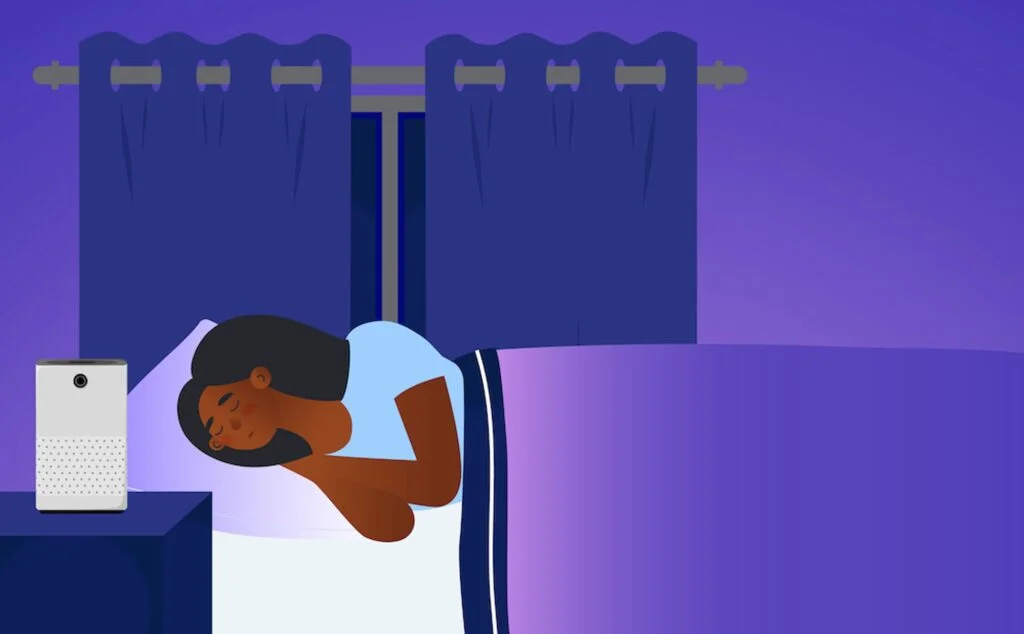
Between barking dogs, noisy neighbors, or a snoring partner, there are a lot of sounds that can keep you up at night. Managing sound is right up there with managing light and temperature when it comes to a healthy sleep environment, which is where white noise may come in (10).
The low hiss of white noise from a machine or app can mask ambient sounds that would otherwise keep you up, and some studies show that white noise significantly improves sleep quality for people living with high environmental noise (11). Colored noises, which have varying strengths and frequencies to produce deep hums or flatter sounds, are also worth investigating if you’re looking for something to help promote sleep.
FAQs
What are ideal sleep conditions?
Managing light, sound, and temperature can help create ideal sleep conditions. The ideal room temperature is around 65 degrees, but may vary a few degrees in either direction depending on the person, their chosen bedding, pajamas, etc.
To support a healthy circadian rhythm, which is strongly influenced by light and dark, maintain a dark sleep environment. Finally, take steps to manage sound. Consider using a noise machine to mask ambient sound if your sleep environment is reliably noisy.
The Last Word From Sleepopolis
“Your bedroom should be a sleep sanctuary,” says Stevens. “In addition to other factors like diet, amount of exercise and stress, your bedroom is a large component of how well you sleep.” Designing your sleep environment to be as soothing as possible, while also managing light, noise and temperature can help promote relaxation so it’s easier to fall and stay asleep.
Sources
- Swanson HL, Ferrari JR. Older Adults and Clutter: Age Differences in Clutter Impact, Psychological Home, and Subjective Well-Being. Behav Sci (Basel). 2022 May 3;12(5):132. doi: 10.3390/bs12050132. PMID: 35621429; PMCID: PMC9137741.
- Caroline J. Rogers, Dr Rona Hart. Home and the extended-self: Exploring associations between clutter and wellbeing, Journal of Environmental Psychology, Volume 73, 2021, 101553, ISSN 0272-4944, https://doi.org/10.1016/j.jenvp.2021.101553.
- Kalmbach DA, Anderson JR, Drake CL. The impact of stress on sleep: Pathogenic sleep reactivity as a vulnerability to insomnia and circadian disorders. J Sleep Res. 2018 Dec;27(6):e12710. doi: 10.1111/jsr.12710. Epub 2018 May 24. PMID: 29797753; PMCID: PMC7045300.
- Circadian rhythms. https://www.nigms.nih.gov/education/fact-sheets/Pages/circadian-rhythms.aspx
- Speaking of psychology: red with anger of feeling blue? The link between color and emotion, with Domicele Jonauskaite, PhD. https://www.apa.org/news/podcasts/speaking-of-psychology/color-emotion
- Chen, Tzu-Ying MSN, RN; Hiyama, Akiko PhD, RN; Muramatsu, Masumi PhD, RN; Hinotsu, Atsuko PhD, RN. The Effect of Lavender on Sleep Quality in Individuals Without Insomnia: A Systematic Review. Holistic Nursing Practice 36(4):p 223-231, July/August 2022. | DOI: 10.1097/HNP.0000000000000528
- Sánchez-Vidaña DI, Ngai SP, He W, Chow JK, Lau BW, Tsang HW. The Effectiveness of Aromatherapy for Depressive Symptoms: A Systematic Review. Evid Based Complement Alternat Med. 2017;2017:5869315. doi: 10.1155/2017/5869315. Epub 2017 Jan 4. PMID: 28133489; PMCID: PMC5241490.
- Blume C, Garbazza C, Spitschan M. Effects of light on human circadian rhythms, sleep and mood. Somnologie (Berl). 2019 Sep;23(3):147-156. doi: 10.1007/s11818-019-00215-x. Epub 2019 Aug 20. PMID: 31534436; PMCID: PMC6751071.
- Afif IY, Manik AR, Munthe K, Maula MI, Ammarullah MI, Jamari J, Winarni TI. Physiological Effect of Deep Pressure in Reducing Anxiety of Children with ASD during Traveling: A Public Transportation Setting. Bioengineering. 2022; 9(4):157. https://doi.org/10.3390/bioengineering9040157.
- Yuki Yamagami, Kenji Obayashi, Yoshiaki Tai, Keigo Saeki, Association between indoor noise level at night and objective/subjective sleep quality in the older population: a cross-sectional study of the HEIJO-KYO cohort, Sleep, Volume 46, Issue 5, May 2023, zsac197, https://doi.org/10.1093/sleep/zsac197
- Ebben MR, Yan P, Krieger AC. The effects of white noise on sleep and duration in individuals living in a high noise environment in New York City. Sleep Med. 2021 Jul;83:256-259. doi: 1016/j.sleep.2021.03.031. Epub 2021 Apr 6. PMID: 34049045.
Seliber-Klein, June. Personal interview. 2023.
Stevens, Christine. Personal interview. 2023.
Leadley, Laura. Personal interview. 2023.
Zhao, Jie. Personal interview. 2023.
Wu, Chester. Personal interview. 2023.


























